COSMOPIRACIES
Debunking the infamous moon landing hoax
- Published On
July 2nd, 2024
- Author
Ayaan Atif
This is Chapter 1 of the three part series of "Cosmopiracies" series, narrated by Cosmoyage, where we explore some of the most widely known theories and claims related to space, from the Infamous Moon Landing Hoax to the Flat Earth Theory. Each chapter will meticulously analyze the claims, scrutinize the purported evidence, and consult experts in the field to provide you with a well-rounded understanding of these intriguing concepts.
Introduction ®
Curiosity. Skepticism. Fascination. Three aspects of human nature that have spread intrigue and doubt about multifaceted things throughout history. Did Shakespeare actually write his renowned plays, or was he merely a front for another writer? Was the Great Fire of Rome an accident, or was it an act carefully orchestrated by Emperor Nero himself? Did Adolf Hitler die in his fuhrer bunker in 1945 or escape to hide in Spain before the Allies could catch him? Such questions never fail to excite the soul and ignite the imagination. They compel us to delve deeper into the records of history, to go through evidence, and to challenge the accepted narrative in order to seek the truth, no matter how elusive it may be.
This is what we are going to do in this six-part series: explore different topics surrounding space that have sparked discussions all around the world for decades in order to simplify the complexities and fuel our desires of uncovering those open ended historical mysteries. Let's start with the most famous of these conspiracies, which is that the moon landing in 1969 by Apollo 11 was faked.
The Cold War ®
The Cold War, a decades-long struggle that developed after the end of World War II between the Soviet Union and the United States of America, was a time when tensions were high. It was a battle to be a global superpower between “two or three monstrous super-states, each possessed of a weapon by which millions of people can be wiped out in a few seconds.”, as described by George Orwell in his October 1945 essay You and the Atom Bomb. The weapon mentioned was indeed the atom bomb, which, in the arms race, piqued the interest of the Soviets under the command of Joseph Stalin due to increased awareness of the US's nuclear power, especially after Hiroshima and Nagasaki. Aware of Stalin’s pursuit of these bombs, the US began developing an even more dangerous weapon: the Hydrogen Bomb. Between 1946 and 1958, an estimated 70 nuclear bombs were detonated, resulting in widespread contamination on the islands between Australia and Hawaii. The largest of these bombs was "Castle Bravo," a 15-megaton bomb detonated over Bikini Atoll on March 1, 1954, which was 1,000 times more powerful than either of the bombs dropped on the Japanese cities of Hiroshima and Nagasaki.
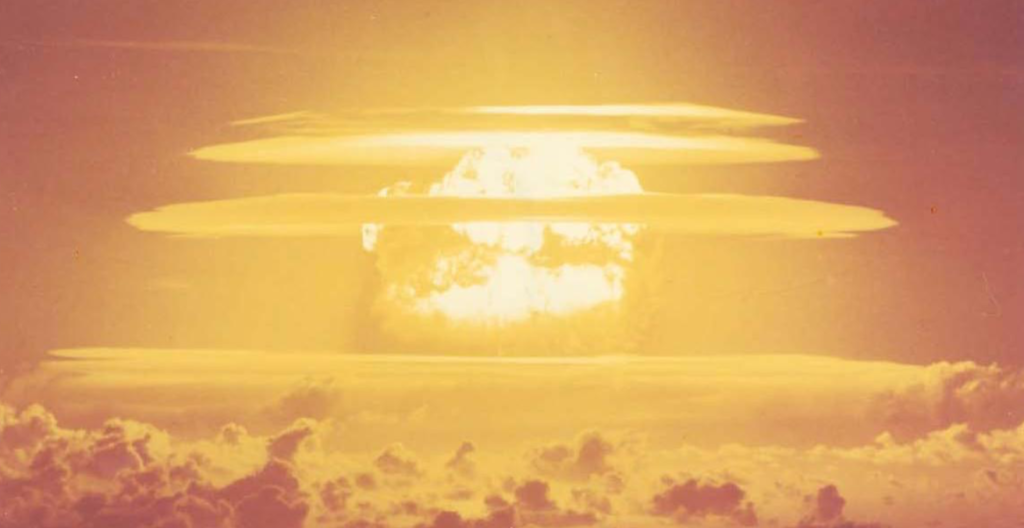
Castle Bravo minutes after detonation
The United States conducted the Castle Bravo nuclear test in the Marshall Islands. The blast spread radioactive fallout across a number of Pacific atolls and left a devastating legacy. (Photo Credit: Australian Institute For International Affairs)
The escalation of nuclear power between both countries along with events such as the construction of the Berlin Wall in 1961, the Cuban missile crisis of 1962, and the outbreak of war in Southeast Asia, eventually led to the start of the infamous space race, which would change the course of mankind forever.
The Infamous Space Race ®
On July 29, 1955, The US announced their intention to launch artificial satellites for the International Geophysical Year. In response, the Soviet Union launched Sputnik, the world’s first artificial satellite, using a Soviet R-7 intercontinental ballistic missile on October 4, 1957, which marked the start of the space race.
In addition to Sputnik 1, the Soviets were also the first to place a man in orbit, which in this case was Yuri Alekseyevich Gagarin, on the 12th of April, 1961. This meant that America was falling behind, and they couldn't afford to lose this battle. This, in the eyes of conspiracy theorists, meant that if NASA couldn't outright win, then it would have to do something unthinkable, which was to convince the world they had really won via nothing less than a total deception.
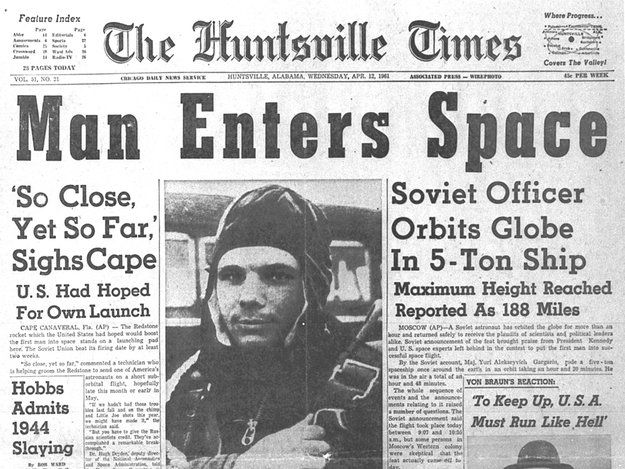
Yuri Gagarin, the 1st human to go to space
The image captures a historic black-and-white photograph of Yuri Gagarin, the first human in space, from the early 1960s. Gagarin, with a confident and determined expression, is suited up in his iconic spacesuit, standing proudly in front of the Vostok 1 spacecraft. (Photo Credit: The Huntsville Times)
On the 12th of September, 1962, the late American President John F. Kennedy delivered a groundbreaking speech at Rice Stadium at Rice University in Houston, Texas, that set the scene for the eventual 1969 landing on the moon. The main part of his speech was as follows:
“We choose to go to the moon in this decade and do the other things, not because they are easy, but because they are hard, because that goal will serve to organize and measure the best of our energies and skills, because that challenge is one that we are willing to accept, one we are unwilling to postpone, and one which we intend to win”
Kennedy's words galvanized the American public and the scientific community, instilling a sense of urgency and purpose in the space race. His vision and leadership were pivotal in driving the United States to achieve one of humanity's greatest milestones: landing a man on the moon and safely returning him to Earth.
The 1969 Moon Landing ®
The Apollo 11 crew consisted of three men: Neil Armstrong, Mission Commander and the first person to walk on the moon; Buzz Aldrin, Lunar Module Pilot; and Michael Collins, Command Module Pilot. They launched into the depths of space inside theSaturn V rocket on July 16, 1969, from the Kennedy Space Center at Merritt Island, Florida, to achieve something previously perceived as nothing more than science fiction. After eight years of hard work, the help of over 400,000 scientists and technicians, and roughly 150 billion dollars in today’s money, the Apollo crew inside the Lunar Module Eagle landed on the lunar surface on the afternoon of July 20, 1969, at 4:17 pm.
As approximately 650 million people watched from our home planet, Armstrong proclaimed, “That's one small step for man, one giant leap for mankind.” This was a statement that will be remembered for generations to come and will always come to mind when we look at the lunar surface shining above our heads.

Neil Armstrong, the first person to walk on the moon

Neil Armstrong, the first person to walk on the moon
The photograph captures a defining moment in human history, depicting Neil Armstrong standing on the lunar surface during the Apollo 11 mission in 1969. Armstrong, in his bulky white spacesuit, appears illuminated against the stark contrast of the moon's desolate landscape. (Photo Credit: NASA)
During their stay on the moon, commemorative medallions with the names of the three Apollo 1 astronauts who lost their lives in a launch pad fire on January 27, 1967, and two cosmonauts who also died in accidents, were left on its surface. Moreover, the astronauts took photographs of the terrain, collected soil samples (about 23 kg worth) planted a U.S. flag, and ran a few simple scientific tests, such as setting up devices to measure the composition of the solar wind and the exact distance between the Earth and the Moon using laser beams for observatories on Earth. While maintaining communication with mission control in Houston, they started their journey back to their home planet after spending 21 hours and 38 minutes on the lunar surface. All three astronauts of Apollo 11 splashed down in the Pacific Ocean west of Hawaii on the 24th of June, where they were immediately placed in quarantine to prevent any spread of possible diseases they might have picked up from the moon.
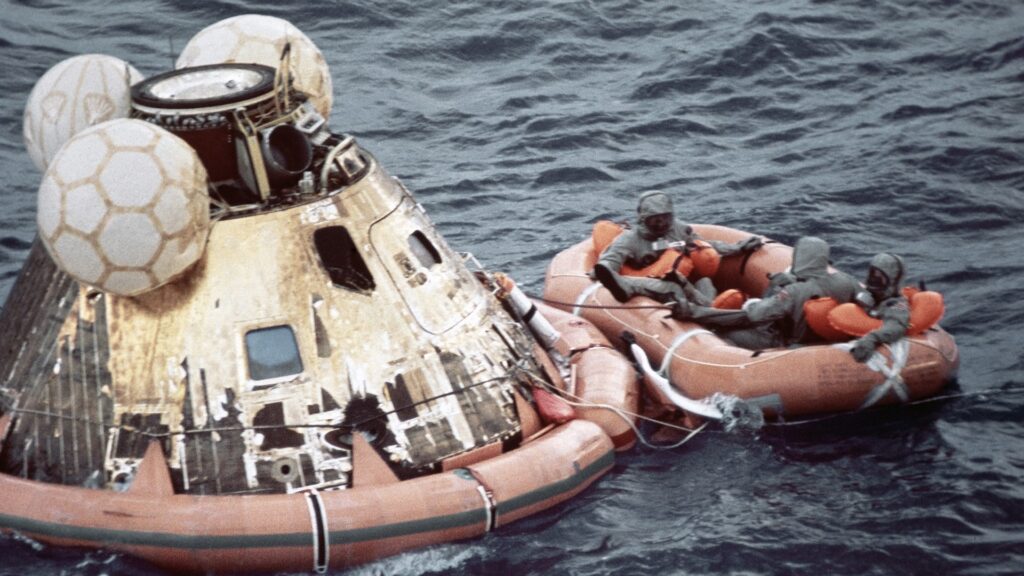
The command module, Columbia, landed 13 miles from the USS Hornet recovery ship at 5:50 AM local time, about 900 miles west of Hawaii

Columbia, landed 13 miles from the USS Hornet at 5:50 AM local time, about 900 miles west of Hawaii
The contrast of the orange lifeboat against the deep blue sea highlights their remarkable journey from the vastness of space to the calm of Earth's oceans, symbolizing their triumphant return from the historic Apollo 11 mission. (Photo Credit: NASA)
They were retrieved by the USS Hornet, a recovery ship, and taken to a specially designed Mobile Quarantine Facility (MQF) to ensure their isolation. This precautionary measure was part of NASA's protocols to protect Earth's biosphere, despite the low likelihood of lunar pathogens. The quarantine period lasted for 21 days, during which the astronauts were closely monitored by medical professionals. Their safe return marked the successful completion of the historic mission, which had captivated audiences worldwide and represented a monumental achievement in space exploration. However, this also led to the rise of conspirators who doubted the authenticity of the moon landing, giving birth to various conspiracy theories.
The Controversial Bill Kaysing ®
Obviously, not everyone agrees that the moon landing was real. In fact, NASA authority James Oberg said, 'There are entire subcultures within the U.S., and substantial cultures around the world, that strongly believe the landing was faked.' He backed this up by stating that the school system on the island of Cuba teaches the moon landing as nothing more than a revolting hoax. Moreover, a Gallup poll taken in 1999 demonstrated that 6 percent of all Americans questioned had at least some suspicions about the Apollo landing, which is quite concerning as it reflected approximately 18 million Americans.
One of the first and most influential points of view in favor of the moon landing being fake came from the book We Never Went to the Moon: America’s Thirty Billion Dollar Swindle, written by the infamous American writer and conspiracy theorist Bill Kaysing. Published in 1974, Kaysing's book argued that NASA lacked the technical prowess to achieve a moon landing and that the event was staged to win the space race against the Soviet Union.
Kaysing’s primary arguments have been elaborated upon by other conspiracy theorists that focused how these key questions:
Why was there a lack of visible stars in many of the pictures said to have been taken by the Apollo astronauts while they were on the moon?
How was it possible that the American flag planted by the astronauts on the surface of the moon seemed to almost wave in one scene?
Kaysing also claimed that NASA was responsible for the fatal fire on Apollo 1 on the 21st of January, 1967, that killed astronauts Virgil Grissom, Edward White, and Roger B. Chaffee, and the Challenger space shuttle disaster of January 28, 1986. He argued that these tragic events were part of a cover-up to hide the truth about the moon landing and other space missions, which was stumbled upon through undeniable evidence regarding NASA’s secret special effects trickery.
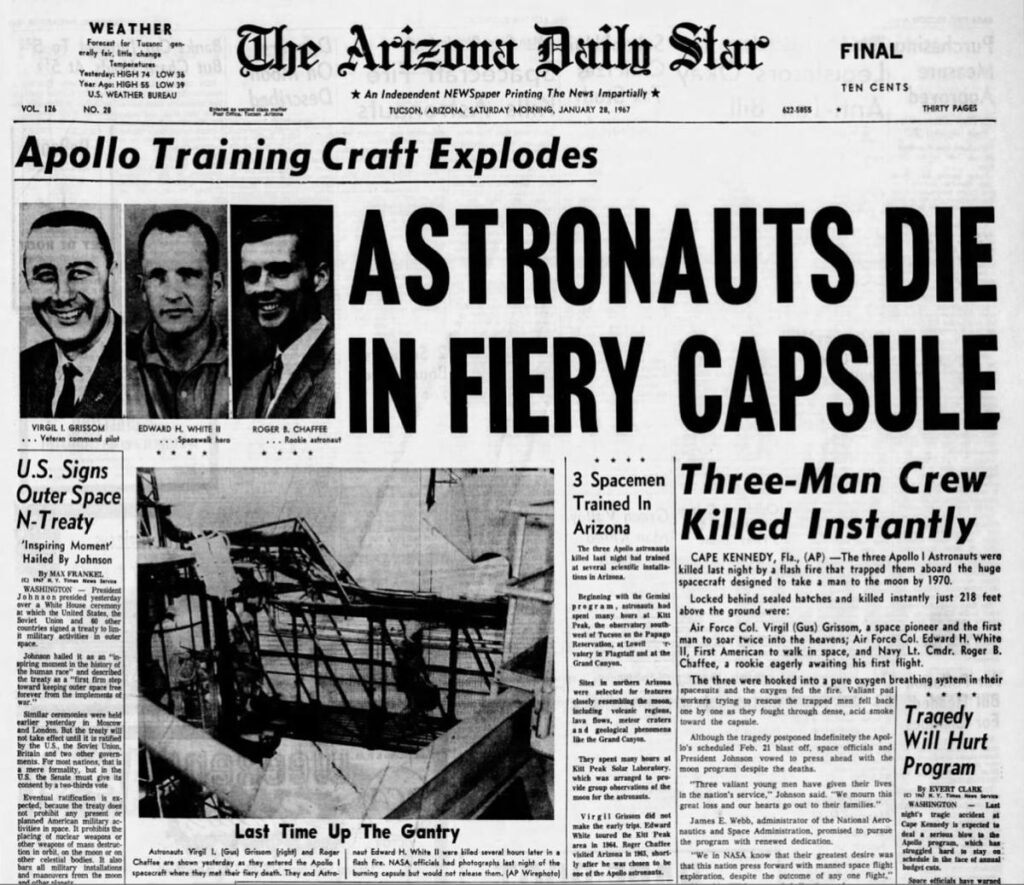
A local American newspaper highlighting the infamous Apollo 1 accident that eventually set the tone for future safety precautions that led to Apollo 11 being successful. (Photo Credit: The Arizona Daily Star)
To bolster his assertion that NASA would not think twice about killing Apollo astronauts to keep a secret, Kaysing said that Thomas Ronald Baron, a quality control and safety inspector for North American Aviation, the company responsible for building the Apollo spacecraft, prepared a lengthy report on NASA safety protocol violations that was provided to a congressional committee investigating the Apollo 1 fire. His report was followed by a further deadly incident where Baron, his wife, and his stepdaughter were killed when their car was hit by a high-speed train. The official verdict concluded that Baron committed suicide and that his family were casualties due to his selfishness and temporary loss of mind. For Bill Kaysing, however, this somewhat mysterious state of affairs was further evidence of a high-level conspiracy by NASA to hide the controversial truth behind the moon landings-as Kaysing believed, the total lack of moon landings, and also the lack of safety protocols, which would surely have had a major bearing on NASA's ability to get to the moon or not.
The “Footprints” on the Moon ®

A local American newspaper highlighting the infamous Apollo 1 accident that eventually set the tone for future safety precautions that led to Apollo 11 being successful. (Photo Credit: The Arizona Daily Star)
These theories and evidence that Kaysing provided won many people over who then started to make bold claims. First, there is the matter of the Apollo astronauts’ footprint which looked clear and evidently carved in the lunar surface as shown in some of the relevant photographs that NASA has shown to the public. Conspiracy theorists have often questioned why the footprints left by astronauts on the moon are so clear and well-defined, given the absence of water and atmospheric erosion. They argue that without water to bind the lunar soil particles, footprints should quickly lose their shape and become indistinct.
In response, NASA and lunar scientists explain that the lunar regolith (soil) behaves differently than Earth's soil. Despite the lack of water, the fine particles of lunar soil have a unique tendency to stick together due to electrostatic forces and the grinding action caused by micrometeorite impacts. When an astronaut walks on the moon's surface, the pressure of their boots compacts the soil particles together, creating sharp and well-defined footprints. This compaction process essentially "freezes" the impression into the regolith, preserving it over time.
Furthermore, the moon's environment, though harsh with its bombardment by meteorites and exposure to solar wind, lacks the continuous erosive forces found on Earth. Without wind or flowing water to gradually wear away surface features, the footprints remain relatively undisturbed. Therefore, the combination of lunar soil properties and the absence of erosive agents on the moon explain why the footprints left by astronauts during the Apollo missions are still visible and distinguishable decades later. All of this serves as an explanation by NASA—a definitive "Take that, conspiracy theorists" rebuttal.
Where is the Starry Sky? ®
A great deal has been discussed regarding the fact that in many pictures NASA insists were taken on the moon by its Apollo astronauts, the skies above don’t show any glimmering stars as we see on our blue planet. Or, to put it simply, the stars are not where they should be. Conspiracy theorists suggest that NASA lacked the necessary skills to accurately determine the precise locations of stars during each of the Apollo missions. As a result, they opted for a simpler solution to resolve this perplexing issue: they completely omitted stars and planets from the imagery. If NASA can put a man on the moon, surely they could find a star or two!
NASA, however, does have an answer to counter this allegation: when the photographs were taken and the film footage was recorded during the Apollo missions, the Apollo Hasselblad cameras used by astronauts were set to capture the bright lunar landscape and details of the astronauts' activities. The primary concern was properly exposing for the bright sunlight and the reflective lunar surface, which naturally made faint celestial objects like stars extremely difficult to capture. Additionally, the fast shutter speeds necessary to photograph the well-lit lunar surface further limited the camera's ability to capture stars, which require longer exposures to appear in photographs.

In stark contrast to Earth's atmosphere, which typically scatters light and dims the stars, the vacuum of space allows for a stunning clarity. Yet, in this photograph, the night sky above the moon appears strangely devoid of stars. (Photo Credit: Discovery)
Furthermore, according to NASA's explanation, the astronauts and mission planners prioritized documenting the lunar exploration itself, including the scientific experiments and activities performed on the surface. The absence of visible stars in the images was a result of these technical considerations rather than a deliberate omission or lack of capability.
Waving Flag ®
What about the infamous waving flag that excited Bill Kaysing and his followers? Yes, there was a scene where the American flag seemed to move about after being secured on the lunar surface by the Apollo 11 astronauts—something that could not be possible on the moon due to the lack of atmosphere. However, the answer to this puzzle is pretty straightforward.
The movement of the flag was actually caused by the astronauts themselves as they planted it into the lunar soil. In the vacuum of space, any disturbance causes objects to move differently than they would on Earth. When the astronauts twisted the flagpole to insert it into the ground, it caused the flag to ripple and appear as though it was waving. This phenomenon occurred because there is no air resistance or wind on the moon to dampen such movements, allowing even subtle actions to affect objects visibly.

When Neil Armstrong and Buzz Aldrin planted the American flag on the moon's surface during the Apollo 11 mission, they reported that the flag appeared to "move" or "wave" after being set in place. This movement was primarily due to the action of inserting the flagpole into the lunar soil. (Photo Credit: NASA)
Shadows on the Surface ®
The argument about the shadows on the moon being fake is a persistent claim among moon landing conspiracy theorists. They often point to photographs where shadows appear to diverge or intersect, suggesting multiple light sources—a phenomenon they argue is inconsistent with the single light source of the sun expected on the moon's surface. This discrepancy, they claim, proves the moon landings were staged in a studio with artificial lighting.
However, experts counter this argument by explaining the principles of perspective and terrain. Professor Ojha, a British space exploration administrator employed at the UK Space Agency, for instance, clarifies that the apparent non-parallelism of shadows is a common optical illusion known as perspective foreshortening. This effect occurs when capturing three-dimensional scenes on a two-dimensional plane, such as a photograph or a video screen. On Earth, observers can witness similar phenomena during sunrise or sunset, where long shadows can appear to converge or diverge due to the angle of the sun and the uneven terrain.
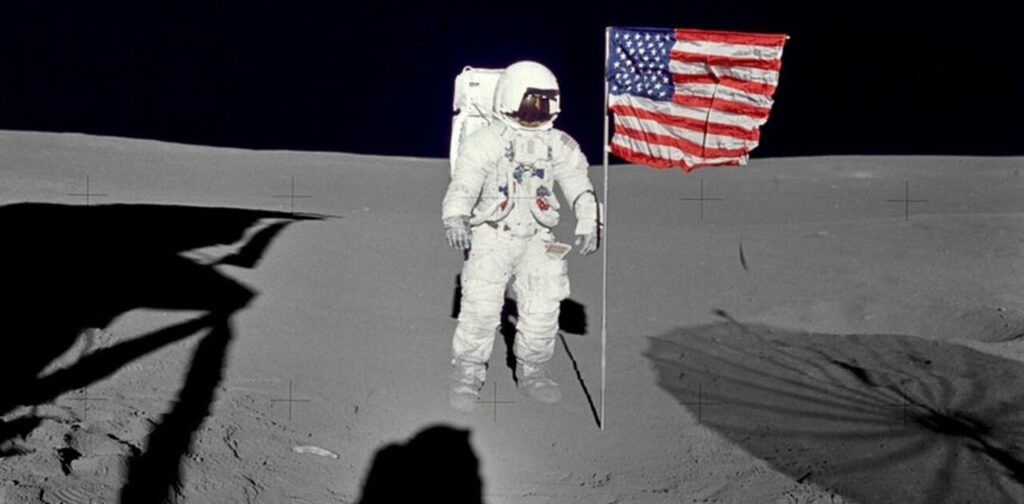
The image depicts the stark lunar landscape, with an astronaut's shadow clearly visible on the moon's surface. The astronaut, dressed in a bulky white spacesuit and helmet, casts a distinct shadow that stretches across the rocky terrain. (Photo Credit: NASA)
Author's Thoughts ®
The thing that baffles me is that conspiracy theorists fail to recognise that close to half a million people worked on the Apollo program and there has not been even a handful of people from that personnel that called it a fake. Moreover, even if only 2 percent of those employed actually knew that the moon landings were not real, we are still talking about close to 10,000 people. Again, could NASA convince all those thousands of people to never ever talk? I don’t think so.
Moreover, while photographs, astronaut testimonies, and film footage might attract conspiracy theorists like moths to a flame, it is far more challenging to dismiss the extensive collection of lunar material brought back to Earth for further testing. Dr. David McLay from the Johnson Space Center has emphasized that these rock samples are dominated by very small craters, which vividly depict the meteoroid impacts characteristic of the moon.
Lastly, the existence of a prepared speech for President Nixon on July 18, 1969, in the event of a disaster underscores the seriousness and foresight involved in the Apollo missions. There was a possibility that it would have ended tragically, with Aldrin and Armstrong potentially stranded on the moon's surface, facing certain death, while Collins orbited above, confronted with the agonizing choice of leaving his comrades behind or returning to Earth alone for their safety. The speech is as follows:
“Fate has ordained that the men who went to the moon to explore in peace will stay on the moon to rest in peace. These brave men, Neil Armstrong and Edwin Aldrin, know that there is no hope for their recovery. But they also know that there is hope for mankind in their sacrifice. These two men are laying down their lives in mankind's most noble goal: the search for truth and understanding. They will be mourned by their families and friends; they will be mourned by the people of the world; they will be mourned by a Mother Earth that dared send two of her sons into the unknown.
In their exploration, they steered the people of the world to feel as one; in their sacrifice, they bind more tightly the brotherhood of man. In ancient days, men looked at stars and saw their heroes in the constellations. In modern times, we do much the same, but our heroes are epic men of flesh and blood. Others will follow and surely find their way home. Man's search will not be denied. But these men were the first, and they will remain the foremost in our hearts. For every human being who looks up at the moon in the nights to come will know that there is some corner of the world that is forever mankind. “
The truth is that everyone is fascinated by conspiracies, and there's little we can do to change that. No amount of evidence can sway the deeply held beliefs of some individuals or dispel the notion that something might be fabricated. The idea of a faked moon landing would require over 400,000 conspirators, which makes it highly improbable to sustain such a large-scale deception for more than 4 years. This complexity only enhances the allure of conspiracy theories, which for many, provide a tantalizing narrative that spices up historical events like sugar in coffee. As long as there are unanswered questions and room for doubt, conspiracy theories will continue to capture the imagination of those intrigued by alternative perspectives on significant moments in history.
Subscribe To Our Newsletter
Receive amazing space news and stories that are hot off the press and ready to be read by thousands of people all around the world.
